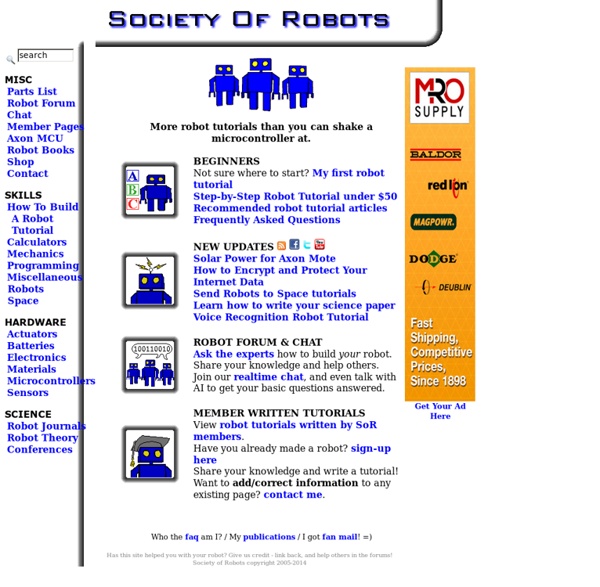



FingerTech Robotics Accueil Evil Mad Scientist Laboratories - Bristlebot: A tiny directional The BristleBot is a simple and tiny robot with an agenda. The ingredients? One toothbrush, a battery, and a pager motor. The result? Serious fun. The BristleBot is our take on the popular vibrobot, a simple category of robot that is controlled by a single vibrating (eccentric) motor. The starting point is of course the toothbrush. Cut off the handle of the toothbrush, leaving only a neat little robotics platform. Next, we need a vibrating pager motor or other tiny motor with an unbalanced output shaft. The kind that I got are happy to run on almost any common voltage– probably a range of 1-9 V. The last substantial ingredient is some foam tape. Attach the motor to the foam tape. A better method is to bend one of the leads down flush with the foam tape, so that you can *stick* the battery to the foam tape as well and still make an electrical connection. The completed BristleBot, running and ready for action.
United States Navy Electricity & Electronics Training Series - NEETS* * These files are Adobe Acrobat files that are 100-400 pages in length and depending on your ISP connection speed may take some time to open. You can also save these files directly to your computer without opening them by right-clicking on the link then select "Save Target As". All text below is copied directly from the forward that is in each NEETS manual: The Navy Electricity and Electronics Training Series (NEETS) was developed for use by personnel in many electrical and electronic related Navy ratings. Written by, and with the advice of, senior technicians in these ratings, this series provides beginners with fundamental electrical and electronic concepts through self-study. The presentation of this series is not oriented to any specific rating structure, but is divided into modules containing related information organized into traditional paths of instruction. Module 8 - Introduction to Amplifiers, covers amplifiers.
Our First Experience with Robotics: Making a Web-Controlled Robotic Arm As part of Programmers’ Day celebration this year, Azoft web developers decided to surprise our fellow Azoft employees with a competition. To try something new and unusual, we created an internet-controlled robotic arm. This was our first experience with robotics and it turned out a success. What does the robotic arm do? Our robotic arm is controlled via a web interface: it responds to remote commands and performs simple tasks. The tasks could vary: from drawing lots in a lottery to grabbing objects and collecting them in a basket - it’s up to your imagination. Have you decided what your robot will be doing? You will need microcontroller TI Stellaris Launchpad two servos (one for rotates, one for lifts) Hitec HS-322 servo TowerPro SG90 for the hand Let's get started The process consists of several stages 0. Stage 0. Getting hold of all the necessary parts can take quite some time, since your nearest shop might not carry all the items you need. Stage 1. Stage 2. Programming Testing 1. 2.
How to Build a Robot Tutorial - Society of Robots Electronics can at first seem extremely complicated to understand and learn. One look at a circuit board with all those little blinky LED's and black chips and unidentifiable circle pointy things can make anyone quit before starting. But actually electronics can be much simpler than you think. Ok first a quick crash course in electron physics. POWERPower is simply the energy required to do something. Ground and Source Source is the positive part of your circuit. Now think of this as water. Water flows down the easiest quickest path between these two points. These do exactly what they say. The last point is important as it is the basis of Ohm's law, V=IR. So about determining the value of a resistor, all resistors have the value labled on them. Now suppose you want to control how the current in your circuit changes (or not changes) over time. Capacitors are somewhat complex in theory, but most people can get by on the basics which I will explain here. How do capicitors charge over time?
Le site du G.D.R. Robotique :. L'annuaire des laboratoires du GDR Robotique Le Groupement de Recherche (GdR) en Robotique a été créé en 2007 par le CNRS. Sa mission est double : • animer et structurer la communauté scientifique du domaine d’une part, • promouvoir, faciliter et dynamiser les échanges entre la recherche et d'industrie d'autre part. A ce titre, le GdR Robotique développe un certain nombre d'actions comme : Le GdR Robotique cherche également à stimuler la recherche collaborative au travers d'un Club des Partenaires (modalités d'adhésion disponibles dans la rubrique "Club des partenaires"). Aujourd'hui, plus de 1300 chercheurs et ingénieurs relevant de différents établissements publics et privés sont membres du GdR Robotique et participent aux travaux de groupes de Travail organisés autour de grandes thématiques correspondant à des enjeux particuliers pour la recherche et l'innovation qui sont : Pour en savoir plus sur les recherches en France dans ces différents domaines, rendez-vous dans les pages des différents Groupes de Travail.
Total Robots, Robotics, Control and Electronics Technology Robotics, Vision & Control The practice of robotics and computer vision each involve the application of computational algorithms to data. The research community has developed a very large body of algorithms but for a newcomer to the field this can be quite daunting. For more than 10 years the author has maintained two open-source MATLAB® Toolboxes, one for robotics and one for vision. This new book makes the fundamental algorithms of robotics, vision and control accessible to all. "An authoritative book, reaching across fields, thoughtfully conceived, and brilliantly accomplished!"